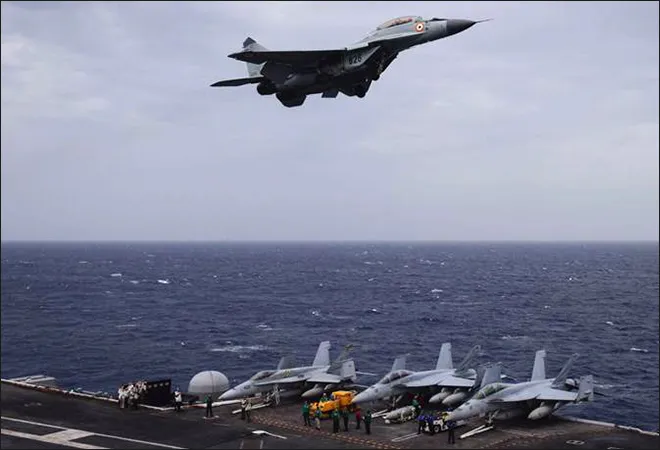
Perceived as the league of like-minded democracies converging across the Indian and Pacific Oceans, the Quad, comprising the US, Japan, India and Australia, is symbiotically linked with the geopolitically ascending region, the Indo-Pacific. However, there are more questions than answers regarding structure, intentions and goals of the Quad at this moment, making it difficult for each member of the Quad to align their combined vision of the grouping with that of their individual visions of the Indo-Pacific. This has led to the debate about the need for re-purposing the Quad. In fact, stopgap sub-unions and disengagements at various levels in the Quad have raised questions as to whether the group can transcend into a productive mini-lateral arrangement from a forum of inhibition. The other issue is whether the Quad is capable of creating a potent security framework in the region and if so, then what would such a structure look like? These questions have primarily cropped up because of two factors. First, while the nations have committed to the idea of a “Free and Open Indo-Pacific”, the cohesion is still loosely arranged and has not yet been formalised at the ministerial level.
One way of looking at it would be that even though the states have a conceptual consensus on the primary idea behind the Quad, their individual politico-security considerations in the region vis-a-vis other players subtly vary.
While all the member states in the Quad have a robust strengthening network of ties with implications in the maritime domain, including security dialogues and military exercises, the quad as a unit has failed to deliver substantively in terms of achievements and commitments towards laying a bedrock of a strong security arrangement in the Indo-Pacific As such, informal promises, some members’ increasing apprehension apropos China and dithering regional resolve from Washington under Donald Trump have have not produced the required joint resolve for concrete deliverables.
India has distinctively carved a space with its emphasis on the principle of freedom of navigation and respect for the laws of the sea, finding resonance with the central ideas of the Quad. However, India’s increasing tangible cooperation with the Quad nations, its reservations about a more formalised security structure in the region, while still balancing at home and its desire to avoid being identified with any particular group with regional security implications at the international stage, is compounding complications in India’s vision of the Indo-Pacific and its vision of the Quad. India’s de-hyphenation of the Indo-Pacific and the Quad not only eclipses clarity but underscores the need for a regional security architecture that emphasizes on a strategic continuum rather than geopolitical fragmentation.
Decoupling the Quad and the Indo-Pacific
While India has engaged with the Quad states actively in the past couple of years since the organization’s resurrection in 2017 after a decade, it has also subtly emphasized on decoupling of the purpose of the Quad with its vision of the Indo-Pacific. New Delhi has drawn conceptual and structural policy demarcations between the Quad and the Indo-Pacific through its actions, inhibitors and statements, outlined in some ways by Ambassador Pankaj Saran. In the aftermath of two important informal summits at Wuhan and Sochi with China and Russia respectively, India’s enthusiasm towards the Quad has appeared faded. As such, New Delhi seeks to place Quad as one of the many multilateral frameworks operating in the Indo-Pacific region, not as the regionally consequential one. India has distinctively carved a space with its emphasis on the principle of freedom of navigation and respect for the laws of the sea, finding resonance with the central ideas of the QuadEnumerating its Indo-Pacific strategy in largely ‘pluri-lateral formats', India seeks to avoid restricting its Indo-Pacific strategy to the Quad at its helm, but also seeks to maintain its long cherished principle of strategic autonomy by keeping its options open to engage with Russia in the region, as also by making conscious decisions not to provoke China.
New Delhi seeks to ensure a nimble-footed balance in the Indo-Pacific between alignment and autonomy. While it separates the Quad with the Indo-Pacific in its emerging discourse, it risks the loss of an opportunity to create a strategic continuum, in favour of regionally fragmented vision. A positive rationale to India’s purpose in the Quad is the need to view the Indo-Pacific as a strategic continuum rather than an assemblage of sub-regionally divided goals, partnerships and alignments. The Quad provides India the opportunity to use its geographic centrality in the region to connect with the strategic ends on either side of the peninsula to enhance its security vision in the Indo-Pacific region extending from the Gulf to the other side of the Strait of Malacca.
Inclusivity and mini-lateralism
At the Shangri-La Dialogue in 2018, Indian Prime Minister Narendra Modi clarified India’s position on the Indo-Pacific by saying that, “India does not see the Indo-Pacific region as a strategy or as a club of limited members. Nor as a grouping that seeks to dominate. And by no means do we consider it as directed against any country.” While Prime Minister Modi made it clear that India’s Indo-pacific strategy is not about cornering or side-lining China in the region, India also stands for a positive vision of the Indo-Pacific that harps on ASEAN centrality and emphasises inclusivity with South East Asia as a core area in the region. In India’s definition of the Indo-Pacific, it “stands for a free, open, inclusive region, which embraces us all in a common pursuit of progress and prosperity. It includes all nations in this geography as also others beyond who have a stake in it.” India has deliberately marked a definitive and conceptual distinction in defining the regional scope of the Indo-Pacific, primarily through a semantic spin in the word ‘inclusive’.
India’s definitive of ‘all’ stakeholders in its Indo-Pacific purpose somewhat dilutes the Quad’s anti-China purpose. This is perhaps both intended and desired by New Delhi as it creates comfortable navigating space in the region for her to hedge against major powers while still avoid antagonism.
The Quad is essentially rejuvenated against the backdrop of an emerging narrative for a free and open Indo-Pacific, and not much for a pan-regional inclusiveness. This narrative is presumably aimed against China, as its heavy militarisation and territorial claims in the South China Sea along with its strategic naval outposts in the Indian Ocean region is being primarily held as the main disrupting force in the region. While as a unit the Quad seeks to balance China in some ways, India has not drawn a clear line vis-à-vis China in the Indo-Pacific. Presently, it is part of the Quad which emphasises on balancing Chinese aggression in the region by seeking a rules-based order, and at the same time it is talking of an inclusive region which is not aimed against any particular country. As such, the limits of ‘inclusivity’ are left undefined in India’s Indo-Pacific discourse. This narrative establishes the notion that India’s vision of the Indo-Pacific isn’t about balancing or restricting China. Rather, the tilt towards the Quad is only a commitment under shared principles and values. The other issue in India’s Indo-Pacific discourse is an inherent dichotomy. India’s vision of the Indo-Pacific and its distinctive inclusiveness in the region is against the premise of mini-lateralism that the Quad presupposes. Then, the puzzling question is whether a certain degree of inclusivity, as sought by India, would make the Quad’s mini-lateralism powerless? In effect, India’s Indo-Pacific vision has added further uncertainty in the regional discourse around grouping and partnerships. And, it is the lack of clarity which is largely rendering the Quad unproductive.
Need for security architecture vision
New Delhi should visualise the Indo-Pacific as a springboard to connect the ends of the two oceans across the maritime expanse of the Indo-Pacific. As New Delhi gradually seeks to bolster its presence in the region and take up the role of a net-security provider, it needs to shed its reluctance to move up to the strait of Hormuz and beyond the Strait of Malacca. While the Quad can be converted into a vehicle to provide a much needed security architecture in the region, its effectiveness would depend upon how much clarity India adds vis-a-vis its own regional mini-lateral engagements in the Indo-Pacific. India needs to outline a clearer stance with respect to its engagements on either side o the spectrum; the rest of the Quad members as well as China. As such, answers to a few questions that could bring clarity to India’s operational strategy in the Indo-Pacific are much needed and in order. Should India continue its strategy of perceiving the Quad and the Indo-Pacific as decoupled or see the two as symbiotic? And, to what extent is India’s Indo-Pacific strategy ‘inclusive’?
Vivek Mishra is Assistant Professor of international Relations at the Netaji Institute for Asian Studies while Udayan Das is a doctoral candidate in International Relations at the Jadavpur University
The views expressed above belong to the author(s). ORF research and analyses now available on Telegram! Click here to access our curated content — blogs, longforms and interviews.




 PREV
PREV



